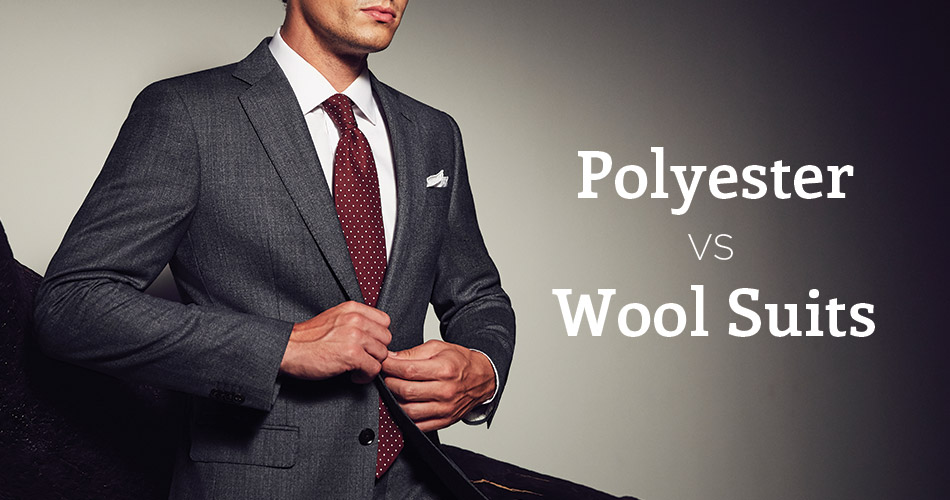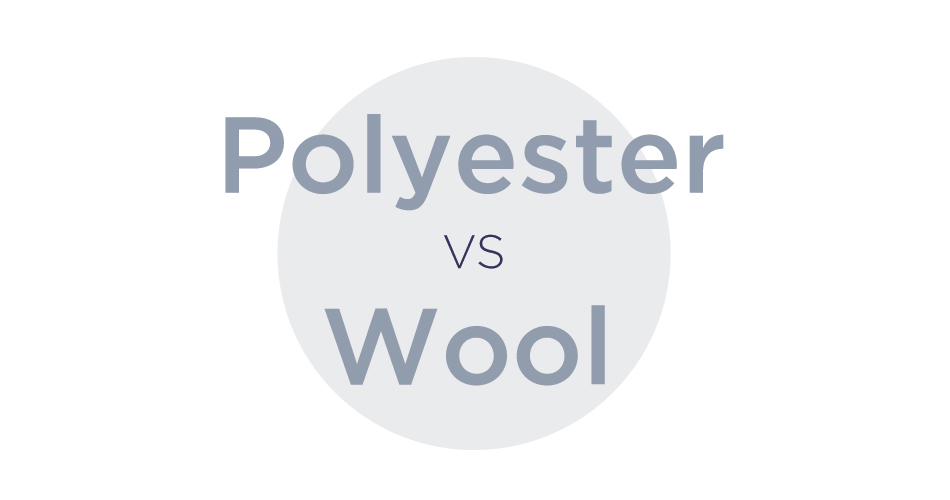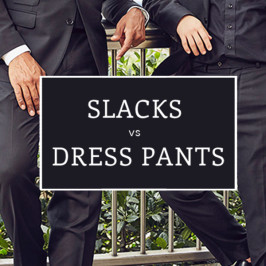Polyester vs Wool Suits: Do Polyester Suits Look Cheap?

The Polyester vs. Wool Suit Matchup
Understanding the polyester vs wool suits question starts with a scenario.
The new guy enters the office on his first day of work. Heads turn as he slips through the door and pauses to get his bearings. A dozen sets of appraising eyes turn his way, scanning him from head to toe. What role is he destined for in the office ecosystem? Will he be the slacker? The overachiever? The future boss?
Then the telltale signs of a cheap polyester suit show up: stiff fabric, poor drape, and slightly too much shine. And the poor guy is just suffocating and sweating it out under that stuffy jacket. The inescapable truth emerges. He’s a bad suit guy.
Whether you’re a new hire at the office, a guest at a wedding, or even just out for a nice dinner, your suit can make a big first, second, and lasting impression. A good suit announces that you take pride in the way you look. This shows you’re not the kind of man who skates by on the bare minimum. A bad suit says, “I only sorta care and my decision-making is questionable at best.” Don’t be a bad suit guy. Learn the polyester vs wool suit differences.
Fabric Matchup: Polyester vs. Wool

There are plenty of factors to consider when buying a suit. This post will go over deciding between polyester vs wool suits, but when it comes down to the nitty-gritty, you’re going to want to focus first on how the suit fits, and then the fabric you’re choosing. You can have all the bells and whistles, but if you get these two things wrong, then you’ve wasted some serious time (and money).
Now there are lots of fancy wools and wool blends that have various uses depending on the season and context. However, in this article, we’re going to focus on the fundamental differences between a wool suit vs polyester suit.
The Polyester Problem
First up, is polyester bad? Quite simply put, the answer is yes. For starters, it’s a synthetic fabric, which means it’s not going to breathe as well as a natural fabric. The synthetic fibers are bad at letting moisture pass through, so unless you’re into looking and feeling like you just got back from the sauna, you’ll be better off with natural fabrics like wool, cashmere, cotton, linen, or silk. Lastly, the yarns used in a polyester fabric have a nasty habit of sprouting shiny wear spots at friction points and anywhere subjected to overly enthusiastic ironing, don’t wear a shiny suit.
Aesthetic value aside, the cheap production value of polyester comes at a greater cost to the environment. Polyester is a synthetic petroleum-based fiber, meaning it is made from a carbon-intensive (and non-renewable) resource. And, it’s synthetic nature means it’s non-biodegradable, meaning it will exist in nature far longer than we will. This article (with infographics) on the environmental impacts of polyester is worth a read.
The Solution – Natural Wool
As far as fabrics go, wool surpasses polyester in both form and function. It’s a natural fiber obtained primarily from sheep, with variants coming from other animals including cashmere and mohair from goats. Wool fiber is incredibly good at absorbing moisture (more so than even cotton), being able to absorb one-third of its own weight in water.
Wool is also extremely versatile, it can be made with open weaves like fresco to enhance breathability and keep you cool in the summer or with raised nap like a flannel finish to improve insulation, keeping you warm in the winter. Lastly, wool is more flame retardant vs synthetic fibers (you’re not going to catch on fire as easily), and its all-natural component means it has a much lower carbon footprint than polyester.
Do Polyester Suits Look Cheap?

You bet they do. We’ll say it one more time for effect: polyester suits look cheap. You know that shiny suit (you’ve seen them) that looks a bit stiff (like plastic) and doesn’t seem to ever want to drape softly? That’s your polyester suit, ladies and gents.
In addition, a brand who’s trying to cut fabric costs is likely to cut corners in other areas, resulting in a suit that’s ill-fitting, poorly constructed and in keeping with fast fashion practices, overly trendy (1-inch lapels anybody?). A polyester suit may seem like a good deal, but it’s doomed to join those embellished Ed Hardy jeans and the rest of your bad fashion investments in the back of your closet.
Being stylish takes work.
We can help with that.
Stay in the know with style tips, how-to's, and so much more with our weekly newsletter.

A Wool Suit Is Worth the Investment
While a 100% wool suit is almost certainly more expensive than a polyester suit, it’s still pretty affordable over its useful life. A $500 navy wool suit that you wear just once a week for two years will cost you less than $5 per wear – about the same cost as your daily Starbucks fix. Do you wear it for five or more years? Well, you do the math. Keep in mind, a good suit is an investment. A properly fitting wool suit will give you more years of wear (provided, of course, that you treat it with the TLC it deserves), given its more durable fibers and resistance to developing unsightly wear spots. A properly cared for wool suit can last for decades.
Then there’s the simple aesthetics. When it comes to polyester vs wool suits, wool is always the more sophisticated choice. It drapes noticeably better than polyester and flatters the body. It’s pleasing to the eye and to the touch, with a richness and softness that polyester can’t match. The multitude of wool types available – with their varying textures, thicknesses, and sheens – means there’s always an option to meet your needs and tastes.

You can choose to buy an all seasonal wool suit (most of them are) for the year-round versatility, or buy one with a raised nap like a wool flannel for the insulation, ensuring you survive the winter months ahead. Or you can choose a fresco wool suit, with its more open weave that allows for breathability, keeping the summer heat at bay. Either way, between polyester vs wool, you have more options with wool suits to diversify insulation.
The Polyester vs Wool Suits Verdict

Mastering your suit game starts before groggy, pre-coffee mornings spent rummaging through your wardrobe. First, you have to invest in quality pieces that can help make the right statement about you. BOGO deals are fine for t-shirts and socks, but when it comes to suits, you should pay attention to your ROI. That is why there is a clear winner in the polyester vs wool suits debate.
A well-fitting wool suit is a wise move, and it doesn’t have to break the bank, although it may require a bit of budgeting. You don’t blink an eye at your $5 triple venti half-sweet non-fat caramel macchiato every morning, yet you don’t own a single well-fitting wool suit? If that’s you, then it’s time to reassess your priorities. Cut the caffeine (or make a fine brew yourself at home for less money), save up for the suit and don’t embarrass yourself at the office. You can buy all the macchiatos you want when your snappy suits and executive potential earn you that corner office.
Your Next Move:
Like What You See? There's More.
We'll send you style advice and intel for the modern man.



Pretty biased comparison by a company trying to sell expensive suits. Of course this comment will never be seen.
I afraid your wool.
This article would have been perfect 50 years ago. With modern manufacturing practices the difference in materials is negligible and would not be able to be identified with 80% or greater accuracy by even the most experienced tailors.
Nylon fabric can be nice too, but like with everything it depends on the quality of nylon or wool, etc. Personally, anything made of wool I can’t wear because it makes my skin itch. Maybe I’m alergic to it. So I have one made of polyester/nylon which is of higher quality, non shiny, drapes reasonably well too, and I wear it when it’s colder. My other one cotton, unlined and breathable for hotter days.
It all depends on how the suit is made – from the seams to the polyester type used. I wear 3 types of suits: wool, wool-polyester blend and polyester ones. I can tell you that in some cases neither the most expert tailor could see the difference between them.
The content of this article is true if we make a cheap-70’s-like polyester vs. wool comparison, but turns into pure non-sense if we replace the cheap polyester with the new generation, high-quality one.
Excessively shiny? Not true. Modern polyester comes in a vast range of colors and can be both matte, shiny or something in between.
Seams don’t last long? They are actually stronger than the natural ones.
Hot as hell? Have you ever heard about “Cool Comfort”? Modern suits aren’t by now mean hot.
Bad fitting and bad draping? We can make a test and you won’t see the difference.
In some cases, I bought a polyester one and asked a specialize tailor to make a wool copy of it in a different color . Most people don’t see the difference in materials.
?
Yes – I understand the issues and concur with all that you say – however you have left one great big key area out of the wool vs polyester-wool fabric equation and that is clothes washing.
Mixed fabrics means that many jackets and trousers can be machine washed at home: this is better for the environemt , cheaper and far more convenient than dry cleaning – which needs toxic solvents, costs a lot and needs an inconvenient trip to the dry-clears every few weeks.
Yes – I love my wool suits – but like many men, I also have mixed fibre jackets and trousers. These are especially great during the hot and humid seasons – and when travelling a lot.
What we need is to find the best mix of fibres and weave to deliver the look and comfort of wool – while at the same time giving the envoronmental and convenince benefits of home cleaning. Now there is a great job for reviewers at “the Compass” to follow up on !
It is the same with shirts – a bit of polyester in the fabric means less creases, faster drying and easier ironing. Now the issue is what weave shirt fabric is best suited to such mixes – oxford or poplin? What percentage mix” My advice is to look for the less common 20-30% polyester: 70-80% cotton mix fabrics rather than the more common “cost-cutting” 70% polyester fabric ones.
best wishes – Paul in the UK